In my years of practicing family law in Texas, I’ve seen many clients worry about proving their common law marriage. Take Sarah, for example. She and her partner were together for over ten years. They never had a formal wedding, but they lived together, shared bank accounts, and called each other husband and wife.
When her partner left, Sarah faced the difficult task of proving their marriage existed in order to claim her share of the assets. That’s when she called me.

“Chris, I think I need a divorce—but my husband says we don’t because we were never married,” she told me.
“You never had a formal wedding, but you both considered yourselves married?” I asked.
“Yes. I called him my husband. He called me his wife. We lived together, and we agreed we were married. He just never wanted government involvement. I was fine with that—until he left and denied our marriage ever existed,” she said.
“I’ve seen this before, Sarah—married when it’s convenient, unmarried when it’s convenient. But the law doesn’t work that way. From everything you’ve told me, you meet the legal requirements for common law marriage,” I assured her.
“So I have a right to my share of the assets?” she asked.
“It looks that way, but let’s go over the legal criteria for proving common law marriage in Texas. I want you to fully understand your situation before we proceed. But don’t worry—I’ll help you,” I told her.
“Thanks, Chris. I’m ready.”
Texas recognizes common law marriages, also known as informal marriages. These are legally the same as traditional marriages. Couples who meet specific requirements can enjoy the same legal rights and protections as those who are formally married. They don’t need a ceremony or a marriage license.
Importance of Proving Common Law Marriage
But it’s crucial to understand that simply living together for a certain period doesn’t create a common law marriage.
However, proving your common law marriage is vital because it affects important legal matters such as property division, child custody, spousal support, and inheritance rights. Without sufficient proof, you might miss out on benefits you’re legally entitled to. In Texas, a common law marriage is based on mutual agreement and public recognition as a married couple—not on how long you’ve lived together. For instance, evidence like joint tax returns, shared leases, and testimonies from friends and family can help establish that the marriage exists.
In this guide, we’ll walk you through the specific requirements and types of evidence needed to prove a common law marriage in Texas. Additionally, it will help you understand your rights and explain how to protect them moving forward.
Definition and Requirements of a Common Law Marriage in Texas
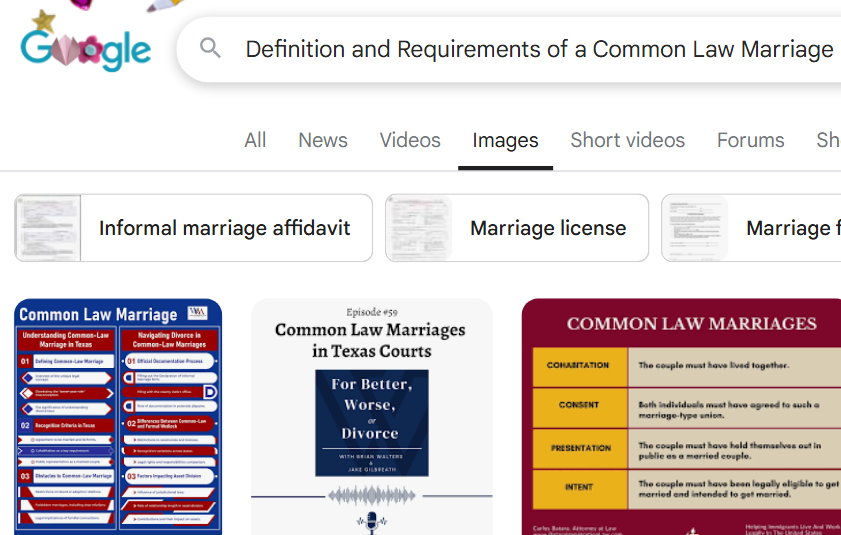
What is a Common Law Marriage?
A common law marriage in Texas is a legally valid marriage that exists without a formal ceremony or marriage license. Instead, it forms when a couple meets specific criteria defined by Texas law, allowing them to be considered married for legal purposes. I want clients to understand that this type of marriage depends on a mutual agreement and actual conduct rather than official paperwork.
This concept goes all the way back to the days when traveling to a courthouse for a marriage license could be difficult. Today, common law marriages remain legally recognized. They give the same rights and responsibilities as formal marriages, including community property rights, inheritance benefits, and even divorce proceedings if the relationship ends.
Specific Criteria for Common Law Marriage
Based on Texas Family Code Section 2.401, three key elements must be present to establish a valid common law marriage:
- Agreement to be married: Both parties must have a present, mutual agreement to be husband and wife (or spouses in the case of same-sex couples). This does not need to be in writing, but both must intend to form a marital relationship.
- Living together in Texas: The couple must cohabitate in Texas as spouses. Contrary to popular belief, Texas law does not require a specific number of years of cohabitation.
- Representing themselves to others as married: The couple must hold themselves out to friends, family, coworkers, and others as spouses.
If a couple stops living together, Texas law presumes no marriage existed—unless someone files a case to prove the marriage within two years of their separation.
Legal Eligibility Under Texas State Law
Not everyone can enter into a common law marriage. According to the Texas Family Code, those who want to form a common law marriage must:
- Be at least 18 years old, as individuals under 18 are typically unable to legally marry in Texas
- Not be related to each other within prohibited degrees
- Have the mental capacity to consent to marriage
After the 2015 Supreme Court decision legalizing same-sex marriage across the United States, same-sex couples in Texas can establish common law marriages if they meet these requirements. I’ve helped several same-sex couples prove common-law marriages that began before 2015 by demonstrating they would have legally married if the law had allowed it at the time.
Proving the Existence of a Common Law Marriage
Gathering Sufficient Evidence
When I help clients prove a common law marriage, I look for various forms of evidence that, when combined, can build a strong case. These include, first, financial documentation such as joint bank accounts, jointly filed tax returns, shared credit cards, mortgage documents, or other legal records. In addition, insurance policies—whether health, auto, or life—that list each other as spouses or name each other as beneficiaries can also support the claim.
Moreover, property records like deeds or leases that bear both names further demonstrate a shared life. While not required, a Declaration of Informal Marriage filed at the county clerk’s office is another helpful piece of evidence. Additionally, estate planning documents, such as wills, trusts, or powers of attorney that refer to each other as spouses, can strengthen the argument.
For example, I once worked with someone who had never filed a formal declaration but successfully proved his common law marriage through ten years of jointly filed tax returns, a joint mortgage, and testimony from several witnesses.
Demonstrating an Agreement to Be Married
Since couples rarely put their marriage agreement in writing, proving it often means gathering different types of evidence. Courts may consider:
- Text messages, emails, cards, or letters referring to each other as spouses
- Social media posts announcing or referencing the marriage
- Testimony from friends or family who heard discussions about being married
- Any written agreement mentioning marital status
One of my clients once found a handwritten letter from her partner that said, “I’m so happy we decided to get married, even if we never had a ceremony.” That note alone greatly strengthened her case.
For a court ruling on the matter, please see Crystal Gayle Caldwell-Bays v. Marvin Bays (2021): A Texas Court of Appeals case where the validity of a common law marriage was contested. The ruling emphasized the need for clear evidence of mutual agreement and public acknowledgment
Holding Out as a Married Couple
“Holding out” means publicly presenting yourselves as married, and it’s a key element in proving a common law marriage. This can be demonstrated in several ways. For example, using the same last name, introducing each other as “my husband” or “my wife,” or wearing wedding rings on your ring fingers all signal the intent to be seen as a married couple.
Additionally, listing each other as spouses on forms for work, school, or medical providers can further support your claim. Having joint memberships in clubs, religious organizations, or other groups also helps show you lived as a married couple. Finally, sworn statements from friends, neighbors, or coworkers can make a strong impact when proving that you consistently held yourselves out to others as married.
The “Case-by-Case Basis” Approach in Court
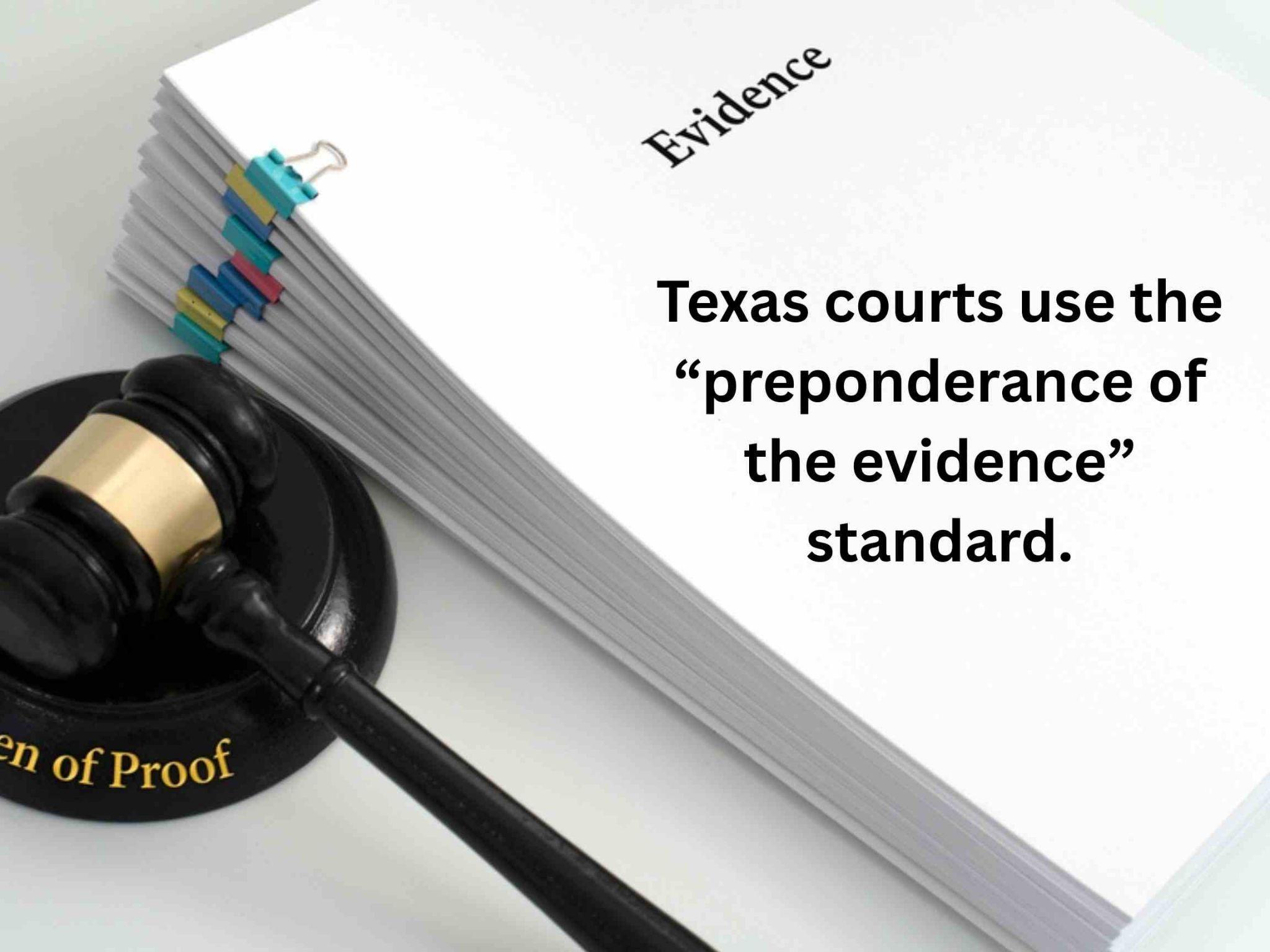
Texas courts decide common law marriage claims on a case-by-case basis, looking at all of the evidence. They use the “preponderance of the evidence” standard, which means you must show it is more likely than not that a common law marriage exists.
As an attorney, I usually:
- Collect and organize all supporting documents
- Prepare witnesses who can confirm the couple’s relationship
- Counter any disputes from the other party
- Present a clear story that shows how the evidence meets the three legal requirements
When one party denies the existence of a common law marriage, things get more complicated. I once represented a client whose partner of 15 years denied they had ever agreed to be married—even in the face of strong evidence to the contrary. We used holiday cards signed “your loving husband” and testimony from their pastor to win the case.
Legal Rights and Obligations of Common Law Spouses
Equivalence to Formal (Ceremonial) Marriage
I always stress to my clients that common law marriages have the same legal effect as formal marriages in Texas. Once established, you have the same rights regarding:
- Property and asset division
- Inheritance
- Hospital visitation
- Medical decisions
- Spousal benefits
- Name changes
- Tax filing status
Texas community property laws consider any property acquired during the marriage as equally owned by both partners.
That’s why it’s crucial to understand marital property rights—individuals in common-law marriages have similar inheritance and property rights as those in formal marriages.
Because of this equivalence, proving that your marriage exists is extremely important if you have a legal dispute.
Community Property State Implications
Texas is a community property state, which affects common law marriages in these ways:
- All income earned during the marriage is owned by both spouses
- Property and assets bought during the marriage belong to both spouses
- Debts accumulated during the marriage may be shared responsibilities
Common law marriages in Texas are subject to the same community property laws as traditional marriages.
Many of my clients have expressed surprise when learning they had rights to retirement accounts, businesses, or real estate acquired during a long-term informal marriage. In one case, a client discovered she could claim half of her partner’s oil and gas investments made during their 12-year common-law marriage.
Child Custody and Support
For common law marriage parents, child custody and child support follow the same rules used for formal marriages. If you divorce:
- Courts look at the child’s best interests to decide custody
- Calculating child support under the same guidelines
- Both parents have an equal right to request custody

It is essential to emphasize the necessity of providing financial support for children in common law marriages, as it ensures the child’s welfare and meets the legal responsibilities of the parents.
I’ve helped many common law couples who split up, sort out custody and support. Often, the hardest part is first proving that the couple was married.
Surviving Spouse and Inheritance Rights
If a common law spouse dies without a will, proving the marriage is essential so the surviving spouse can claim inheritance rights. Depending on the situation, you might be entitled to:
- A share of community property
- Homestead rights
- Certain personal property allowances
- Possible inheritance of separate property
Without estate planning, a common law spouse’s death can lead to legal confusion. I usually suggest that common law spouses prepare wills, name each other as beneficiaries where needed, and consider trusts to protect each other’s interests.
Please see Estate of Claveria v. Claveria (1981) to see how a probate dispute led to the court having to determine whether a common law marriage existed. The Texas Supreme Court ruled that there was sufficient evidence to prove the marriage, reinforcing the importance of demonstrating agreement, cohabitation, and public representation
Common Law Divorce: Ending an Informal Marriage
Understanding Common Law Divorce
There is no informal divorce in Texas. If you decide to end a common law marriage, you must go through the same divorce process as a formally married couple, which involves:
- Filing a divorce petition
- Dividing community property and debts
- Establishing child custody and support (if applicable)
- Reviewing whether spousal maintenance (alimony) applies
I have guided many clients through this process. Often, you must prove the marriage existed, then handle the issues any divorcing couple would face.
Avoiding Common Pitfalls
A significant challenge in common law divorces arises when one partner denies that a marriage ever existed. To help prevent this situation, I suggest several proactive steps. First, filing a Declaration of Informal Marriage with the county clerk while the relationship is stable can serve as strong evidence. Next, it’s important to keep detailed records of joint financial accounts, insurance policies, and shared tax returns, as these documents help establish a history of mutual commitment.
Additionally, saving written notes, cards, emails, or text messages that reference your marital status can provide further support. Another step to consider is creating a post-marital agreement that acknowledges the existence of the marriage and outlines each partner’s property rights. For clients with significant assets, I often recommend prenuptial or post-nuptial agreements that not only recognize the common law marriage but also help safeguard individual property.

Step-by-Step Guide: How to Prove Your Common Law Marriage in Texas
After helping many clients, I’ve developed a simple approach:
1. Check Your Eligibility
Make sure:
- Both you and your partner are at least 18
- Neither of you is married to someone else
- You are not closely related
- You both can legally consent to marriage
2. Document Your Agreement
Gather proof that shows you both agreed to marry:
- Keep cards, emails, or texts referencing marriage
- Note times you called each other husband/wife
- Ask witnesses who heard you agree to marry
3. Demonstrate Cohabitation
Collect evidence that you lived together as spouses:
- Lease or mortgage documents listing both names
- Utility bills at the same address
- Driver’s licenses or IDs with the same address
- Mail addressed to both of you
4. Show You Held Yourselves Out as Married
Prove that you represented yourselves publicly as married:
- Statements from friends, family, or coworkers
- Photos of both of you wearing wedding rings
- Forms where you listed each other as spouses
- Social media posts identifying your marriage
5. File a Declaration if Possible
Filing a Declaration of Informal Marriage with the county clerk’s office is strong evidence. You can obtain a Declaration of Informal Marriage form from your county clerk’s office in Texas. You’ll need:
- Both partners to go together
- Valid ID
- A small fee
- Both signatures
Both partners must swear they are common-law married to each other when completing the Declaration of Informal Marriage form.
6. Seek Legal Help
If you need to prove your common law marriage for legal purposes, it is crucial to seek legal counsel from an experienced family law attorney who can:
- Review your situation
- Spot your strongest evidence
- Gather extra documentation
- Represent you in court if needed
From my experience handling many common law marriage cases, professional guidance often makes it much more likely you’ll succeed in proving your marriage.
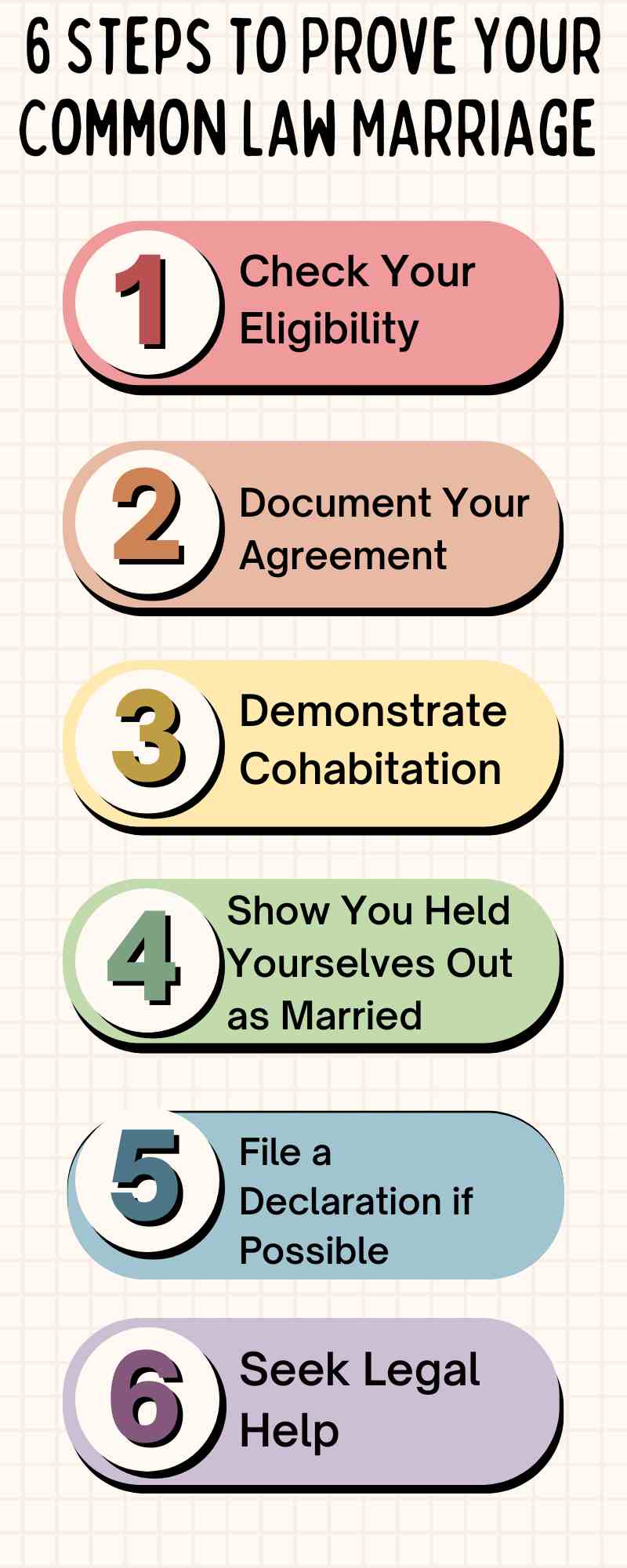
Frequently Asked Questions
FAQs About Legal Requirements
What are the three legal requirements for establishing a common law marriage in Texas?
Under Texas Family Code Section 2.401, a valid common law marriage (informal marriage) requires three specific elements happening at the same time:
- Both partners must have a present, mutual agreement to be married (not a future promise).
- The couple must live together in Texas as spouses (there’s no minimum time).
- They must represent themselves to others as married (“holding out”), which can sometimes include formal agreements such as to manage assets.
You must prove all three elements with sufficient evidence. Courts use a case-by-case basis and the preponderance of the evidence standard, meaning it’s more likely than not a marriage exists.
Is there a minimum time requirement for living together to establish a common law marriage in Texas?
No. Texas law does not set any minimum period of cohabitation. The common belief that you must live together for seven, five, or three years is untrue and has no support in Texas statutes. The key is that the three requirements (agreement, cohabitation, and holding out) exist at once.
Time does matter if you separate, though. If you don’t start a proceeding to prove the marriage within two years of splitting, Texas law presumes there was no common law marriage. This rule does not apply if one spouse dies. If you wait more than two years after separating to prove a common law marriage, the law presumes you never intended to be married.
FAQs About Documentation & Proof
What documentation best proves a common law marriage in Texas?
A Declaration of Informal Marriage filed with the county clerk’s office is the strongest single document. Other helpful documents include:
- Joint tax returns filed as “married”
- Insurance policies listing each other as spouses
- Mortgage or lease agreements with both names
- Joint bank or credit card accounts
- Work or medical forms naming your partner as a spouse
- Written communications (cards, emails, social media) referring to each other as spouses
- Other legal documents
Courts look at everything you can provide, so the more proof you have, the stronger your case—especially if your partner later denies the marriage.
How do you prove the “agreement to be married” element in Texas?
You must show that both partners intended to create a legal marriage relationship right away, not in the future. Since there isn’t usually a written or recorded statement, courts often rely on:
- Witnesses who heard a clear statement about being married
- Letters, emails, or texts where one partner acknowledges the marriage
- Actions like filing joint tax returns as married
- Listing each other as spouses on various documents
- Wearing wedding rings or other clear signs of marriage
- A Declaration of Informal Marriage (the best evidence)
The agreement has to happen before or at the same time as cohabitation and holding yourselves out as spouses.
How do you prove you “held yourselves out” as married in Texas?
“Holding out” means telling others that you are married. Courts consider:
- The way you introduced each other (e.g., “my husband” or “my wife”)
- What friends, family, and neighbors believed
- Whether you shared a last name publicly
- Rings or other outward signs of marriage
- Official documents showing you called each other spouses
- Social media or holiday cards referencing your marriage
You need consistent and widespread actions to show real holding out, not just occasional references.
What happens if one spouse denies the existence of a common law marriage?
This is often the toughest situation. If your partner denies you had a common law marriage, you bear the burden of proving the three elements to establish common law marriage. You will need:
- Firstly, joint financial records
- Secondly, letters, texts, or emails mentioning the marriage
- Thirdly, witnesses who can confirm you held yourselves out as married
- Fourthly, any documents showing your partner once claimed you as a spouse
In these disputes, hiring an experienced family law attorney makes a big difference. From my time representing clients on both sides, the strength and organization of your evidence can decide the outcome.
FAQs About Rights & Special Situations
Does having children together automatically create a common law marriage in Texas?
No. Having children does not automatically form a common law marriage. You must still prove the same three elements: agreement, cohabitation, and holding out.
However, if you listed each other as spouses on your child’s birth certificates, school forms, or medical paperwork, that can help support a claim of holding yourselves out as married. But parenthood alone is not enough to establish a common law marriage.
Do same-sex couples qualify for common law marriage in Texas?
Yes. Same-sex couples in Texas can meet the same requirements as opposite-sex couples to form a common law marriage. Since the 2015 Obergefell ruling by the Supreme Court, courts have allowed same-sex couples to show that their common law marriage began once they first met all the requirements—even if that date was before same-sex marriages were legal.
I’ve represented same-sex couples looking to prove the start of their common law marriage to handle property division or inheritance rights. These cases often need thorough proof of when the couple first agreed to marry and began presenting themselves as spouses.
Do common law spouses have the same legal rights as formally married couples in Texas?
Yes. After a common law marriage is established, it is treated exactly like a formal marriage. You get:
- Firstly, community property rights (equal shares of what’s earned during the marriage)
- Secondly, inheritance rights
- Thirdly, medical and hospital visitation rights
- Fourthly, possible spousal maintenance
- Fifthly, access to benefits, tax advantages, and Social Security benefits
- Sixthly, child custody and support rights
Texas courts treat issues like property division, child custody, and spousal support the same for both common law and ceremonial marriages. The difference is that, in a dispute, you might first have to prove the marriage.
Can we still have a formal ceremony if we’re common law married?
Absolutely. Many couples who already have a common law marriage choose a formal ceremony later for personal or religious reasons. I’ve seen clients celebrate a wedding even after being common law married for years. It doesn’t change your legal status, but it can be a nice way to share your commitment publicly. If you already filed a Declaration of Informal Marriage, you don’t need a marriage license.
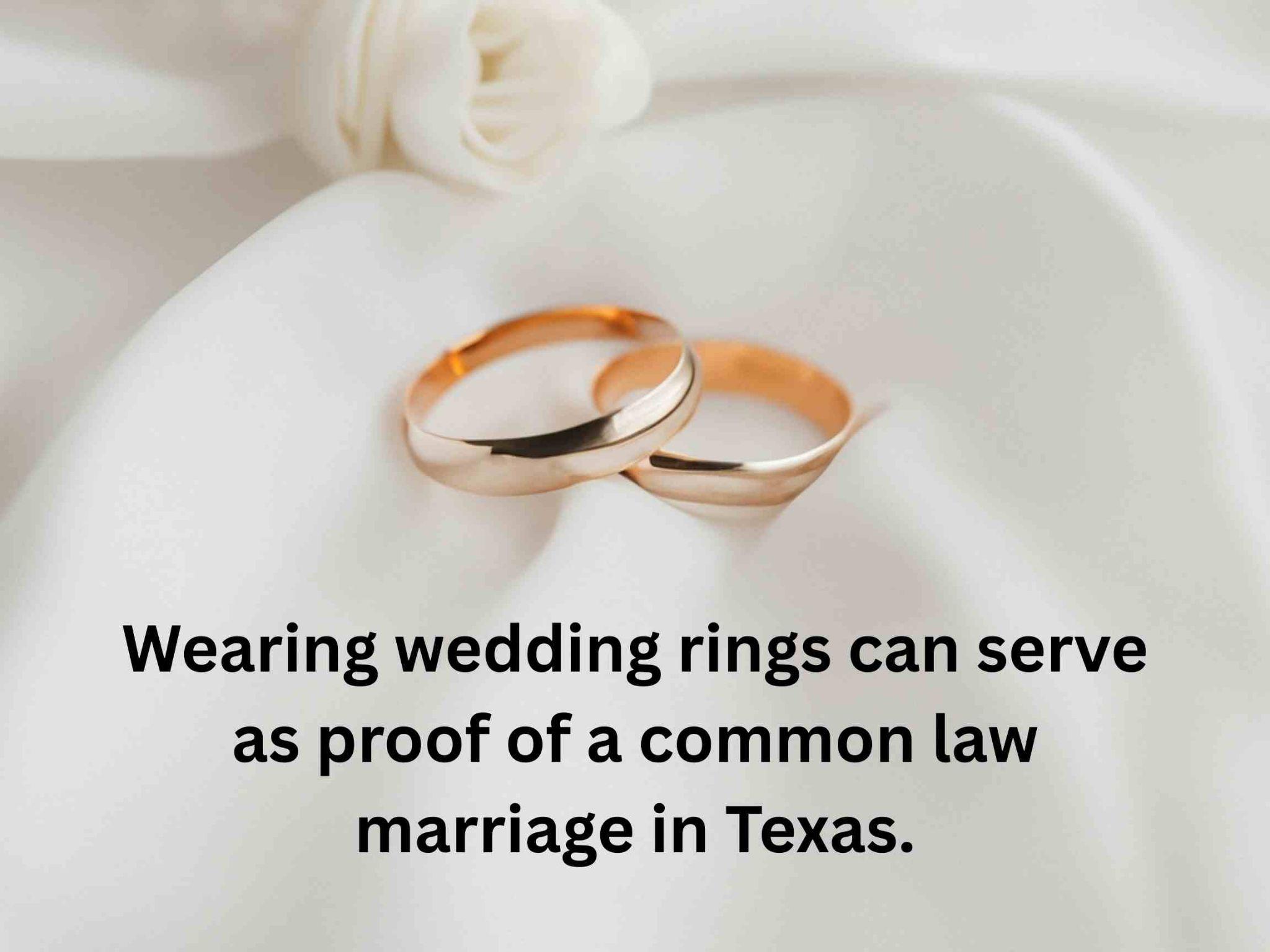
Conclusion: Protecting Your Rights and Establishing Your Common Law Marriage
In my experience, properly documenting and affirming a common law marriage is essential. Whether you need to establish your marriage for purposes such as property division, inheritance rights, or other legal benefits, understanding the legal requirements and gathering the right evidence is key.
It’s important to remember that under Texas law, common law marriages are treated the same as formal marriages. Once established, a common law marriage carries the same rights and obligations—impacting property ownership, inheritance, and even parental rights.
To avoid future complications, a proactive approach is best. Filing a Declaration of Informal Marriage with the county clerk, keeping thorough records of shared finances and jointly owned property, and consulting with a family law attorney can help protect your interests.
If you ever need to prove a common law marriage—whether after a breakup or the death of a partner—focus on gathering evidence of your mutual agreement to be married, your cohabitation, and the ways you presented yourselves as spouses to others. With careful planning and the right documentation, you can establish your common law marriage and ensure your rights are protected under Texas law.
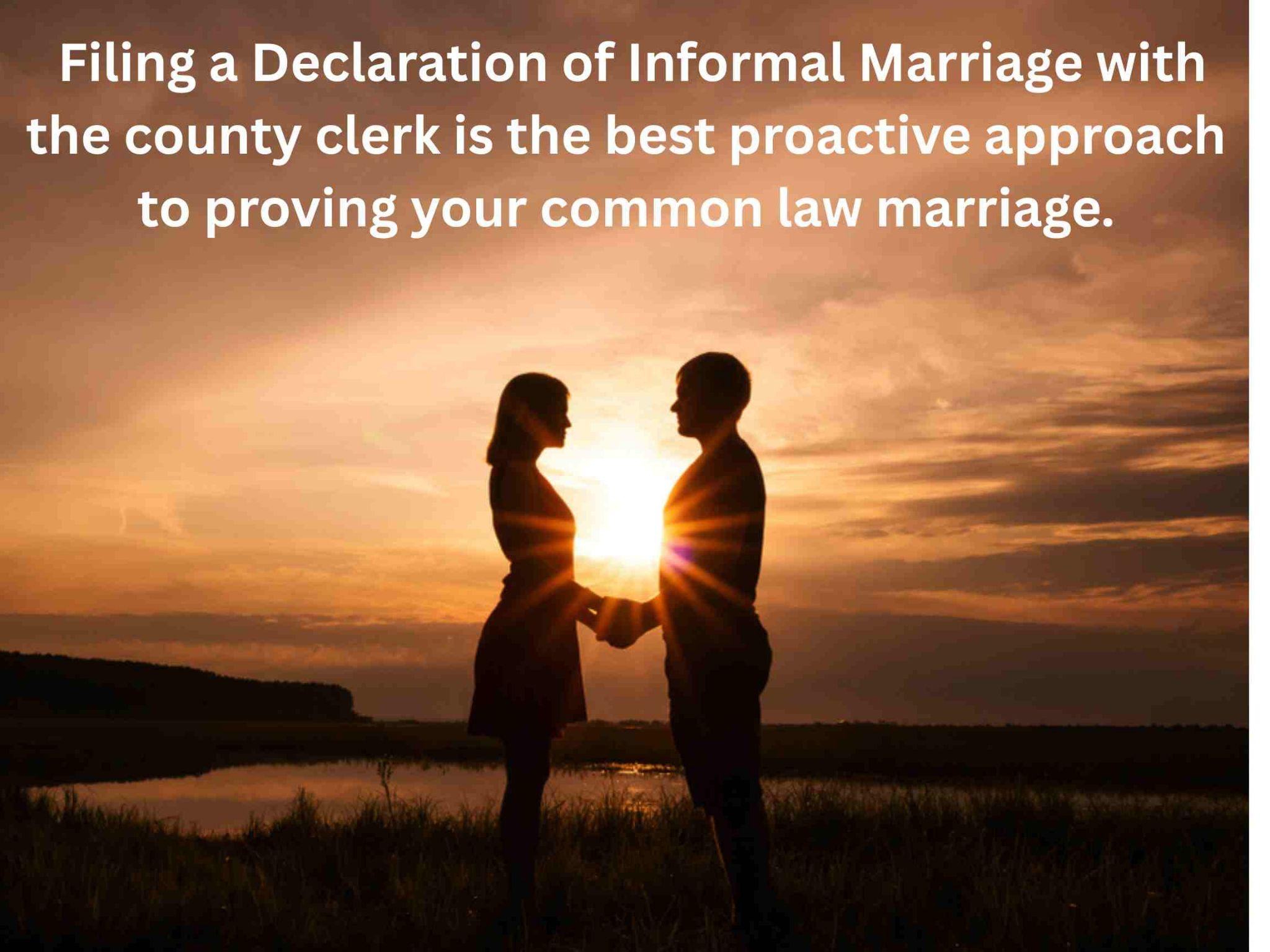
Does Sarah Have Proof?
“Chris, there’s so much that proves we were married. But I know he’ll try to hide behind the fact that we never had a wedding,” she said.
“Why do you think that?” I asked.
“Because he’s all but said it. He told me that if he wanted to get married, he would have done it. Now, he’s saying we weren’t—despite always acting like we were,” she explained.
“Sarah, do you remember the three elements needed to prove common law marriage?” I asked.
“Yes—agreement, cohabitation, and holding out,” she answered.
“That’s right. Even though he’s denying the marriage, do you think you can gather proof to demonstrate those three things?” I asked.
“Easily. We shared a home. We had joint bank accounts and insurance policies. And there are plenty of people who can testify that we called each other husband and wife. Everybody knows,” she said.
“Well, you have strong proof. Maybe he just doesn’t understand what the law actually says. We’ll explain it to him, and if he continues to deny the marriage, we’ll present the evidence to prove it,” I told her.
“And then I can get a divorce and get my share?” she asked.
“One step at a time—but yes, that seems likely,” I assured her.

Schedule a Consultation With Our Firm to Find Out How to Prove Common Law Marriage in Texas
Trying to prove a common law marriage in Texas can be stressful and challenging, but you do not have to face it alone. Our team of experienced Dallas family attorneys is ready to provide you with the guidance, support, and legal advocacy you need during these challenging times.
Whether you are trying to prove a common law marriage or navigating other family law issues, we are here to help you every step of the way. We welcome you to schedule a consultation to discuss your situation and case objectives. We can answer your legal questions and discuss how we can help you move forward. Call our law office at (888) 584-9614 or contact us online to schedule your consultation.
Disclaimer: This article is for informational purposes only and does not offer legal advice. Each case is unique, and the details here may not apply to your specific circumstances. If you need legal assistance with a common law marriage matter, consult a qualified attorney.

